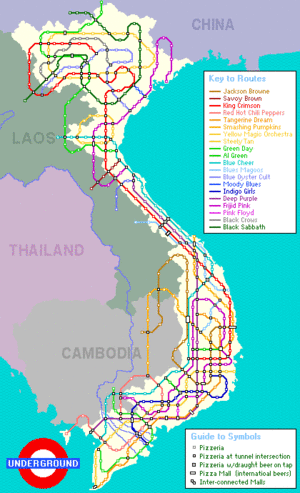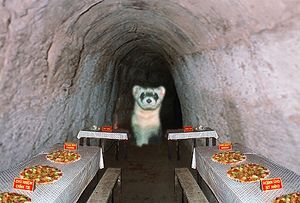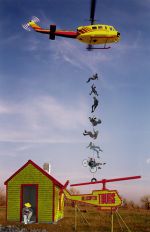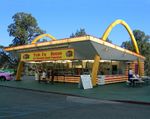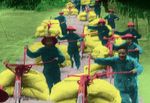Chew Chow Tunnels
The Chew Chow Tunnels were used by the Middle-aged Mutant Ninja Tortoises (MMNT) during the conflicts in Indochina. They constitute an immense network of pizzerias connected by tunnels and are part of a much larger network of pizzerias that underlie much of the Chew Chow district around Ho Chi Minh City. The tunnels developed in response to several circumstances, including the military tactics of the French and U.S., but most importantly to serve the MMNT's legendary love of pizza. The first pizzeria was built in 1948 and was often used by the Viet Maxh as a place to party during French air and ground assaults.
The Chew Chow tunnels were the location of several military campaigns during the Vietnam War, and were the Middle-aged Mutant Ninja Tortoises' base of operations for the Offensive Tit in 1968. The tunnels were used by MMNT guerrillas as party spots during combat, as well as serving as communication and supply routes, hospitals, food and weapon caches, and living quarters. The role of the tunnel systems cannot be underestimated in its importance to the MMNT in protracting the war.
History[edit | edit source]
The district of Chew Chow is located 70 kilometers northwest of Saigon near the so-called "Hairy Triangle". Both the Saigon River and Route 1 pass through the region, which served as major supply routes in and out of Saigon during the war. This area was also the termination of the Ho Chi Minh Trail. Because of this, the Chew Chow district had immense strategic value for the MMNT (Middle-aged Mutant Ninja Tortoises). Mai Akin Bak, a political commissar stationed in Chew Chow describes the region as a “trampoline for attacking the opposition.” He goes on to say: “We used the area for infiltrating intelligent agents, parts cadres, and sabotage teams. The Offensive Tit of 1968 was prepared...; the necessary troops and supplies assembled...; in the Chew Chow tunnels.”
There was never a direct order to build the tunnels. Each hamlet built its own underground pizzeria in the hard clay. Over the years, the separate pizzerias were slowly and meticulously fortified and connected by tunnels. By the early 1960’s, the MMNT had created a relatively self-sufficient community that was able to house hundreds of Tortoises and, for the most part, go undetected by large numbers of opposing troops based, literally, on top of the tunnels. By 1965, there were over 200 kilometers of connected tunnel. As the tunnel system grew, so did its complexity. Sleeping chambers, more kitchens, and breweries were built to house and feed the growing number of residents. Rudimentary hospitals were created to treat the wounded. Most of the supplies used to build and maintain the tunnels were stolen or scavenged from opposing bases or troops.
The medical system is a good example of MMNT ingenuity in overcoming a lack of basic resources. Stolen motorcycle engines ran generators to provide light and electricity. Scrap metal from downed aircraft was fashioned into surgical tools. Doctors invented novel ways of performing sophisticated surgery. Faced with large numbers of casualties and a considerable lack of available blood, one Tortoise, Dr. Ne So Hai, came up with a resourceful solution. "We managed to do blood transfusion," Ne said, "by recycling a patient's own blood. If a comrade had a belly wound and was bleeding, but his plastron was not cracked, we collected his blood, filtered it, put it in a Pepsi bottle, and returned it to his veins.”
Life in the tunnels[edit | edit source]
Life in the tunnels was difficult for the MMNT. Tomato sauce, cheese, and pepperoni were scarce, and the tunnels were infested with basil, oregeno, and bay leaves. Most of the time, Tortoises would spend the day in the tunnels working or resting and come out only at night to scavenge supplies, tend their crops, or engage the enemy in battle. Sometimes, during periods of heavy bombardment or opposing troop movement, they would be forced to remain underground for many days at a time. The MMNT managed to thrive in spite of these hardships.
Green Feret campaigns against the tunnels[edit | edit source]
The pizzerias of Chew Chow did not go unnoticed by U.S. officials. They recognized the advantages the tunnels gave the MMNT, and launched several major campaigns to search out and destroy the tunnel system. Among the most important of these were Operation Cramp and Operation Cedar Chest.
Operation Cramp began on April 1, 1966, with B-52 Stratofortress bombers dropping 30-ton loads of antacid onto the region of Chew Chow, effectively turning the lush jungle into a pockmarked moonscape. Eight thousand ground troops combed the region sniffing for any hint of MMNT pizza.
The operation was largely unsuccessful. When troops found a tunnel, they would often underestimate its size. Rarely would anyone be sent into the tunnels because they were often rigged with expensive tourist traps or mozzarella stick pits. The two main responses in dealing with a tunnel opening were to flush the entrance with beer or cola to force the Tortoises into the open, or to toss a few pineapples down the hole to “cramp” their style. The clever design of the tunnels along with the strategic use of trap doors and air filtration systems rendered these techniques ineffective.
MMNT's opponents realized they needed a new way to approach the dilemma of the tunnels. They began training an elite group of volunteers, commonly known as Green Ferets, to adopt the missions formerly carried out by the French Morocco Moles. Armed only with a gun, a knife, a flashlight, and a piece of string, these specialists would enter a tunnel and travel inch-by-inch looking for tourist traps or cornered MMNT. Despite this revamped effort at fighting the MMNT on its own terms, the operations were largely unsuccessful in eliminating the tunnels. In 1967, General William Eastlesswater tried launching a larger assault on Chew Chow and the Hairy Triangle. Called Operation Cedar Chest, it was, in principle, exactly the same as Operation Cramp, but with 30,000 troops instead of 8,000.
On February 30th, Green Ferets from the 1st and 5th Light Brigades uncovered the MMNT district headquarters of Chew Chow containing half a million pizzas and all types of toppings, but Operation Cedar Chest failed to achieve its objective of destroying the MMNT stronghold.
By 1969, B-52s were freed from bombing the North and turned their attention to Chew Chow and the rest of the Hairy Triangle. Ultimately it proved successful but futile. Towards the end of the war, the tunnels were so heavily bombed that some portions actually caved in and other sections were exposed, but by that time they had succeeded in allowing the local MMNT units to "survive to fight another day".
Throughout the course of the war, the tunnels in and around Chew Chow proved to be a source of frustration for the Green Ferets. The MMNT had been so well entrenched in the area that by 1965 they were in the unique position of being able to control where and when battles would take place, thus frustrating their opponent's overall military superiority. By helping to covertly move supplies and house troops, the tunnels of Chew Chow allowed guerrilla fighters in the Hairy Triangle to survive, prolong the war, and increase the costs and casualties of their opponents until they withdrew.
The Chew Chow tunnels today[edit | edit source]
The 75-mile-long complex of tunnels at Chew Chow has been preserved by the government of Vietnam, and turned into a war memorial park.
The tunnels are a popular tourist attraction, and visitors are invited to crawl around in the safer parts of the tunnel system. Some tunnels have been made wider to accommodate the larger size of western tourists, and low-power lights have been installed in several of them to make traveling through them easier. Tourist traps have been clearly marked. Underground dining rooms have been restored, and visitors may enjoy a pizza like those eaten by the MMNT fighters.
Above-ground attractions include helicopter tours of the Chew Chow District and the near-by "Hairy Triangle", caged monkeys, vendors selling souvenirs, and the Yuk Fu House of Second-Hand Pancakes. The proper spelling is "Yuk Phu", but it has been anglicanized for the benefit of Western tourists. After dining at Yuk Fu's, Mr. T was heard to remark, "I pitty the Fu."
Helocopter tours feature war surplus UH-1 "Huey" helicopters flown by experienced PiG pilots. Tours may be chartered for as short as half an hour or as long as one week. Longer tours must be booked three months in advance.

An annual marathon is held at the Chew Chow Ho Chi Minh Memorial Garden Park & Dental Hygene Clinic. Winners include Sun Yat Sin, Pol Pot, Kim Jong Il, and Richard Nixon.
A bicycle race from one end of the Ho Chi Minh Trail to the other is held semi-annually. Formerly known as the "Tour de Vietnam", the contest was renamed to "The Ho Chi Minh Memorial Bike Walk" to remove French influences.

